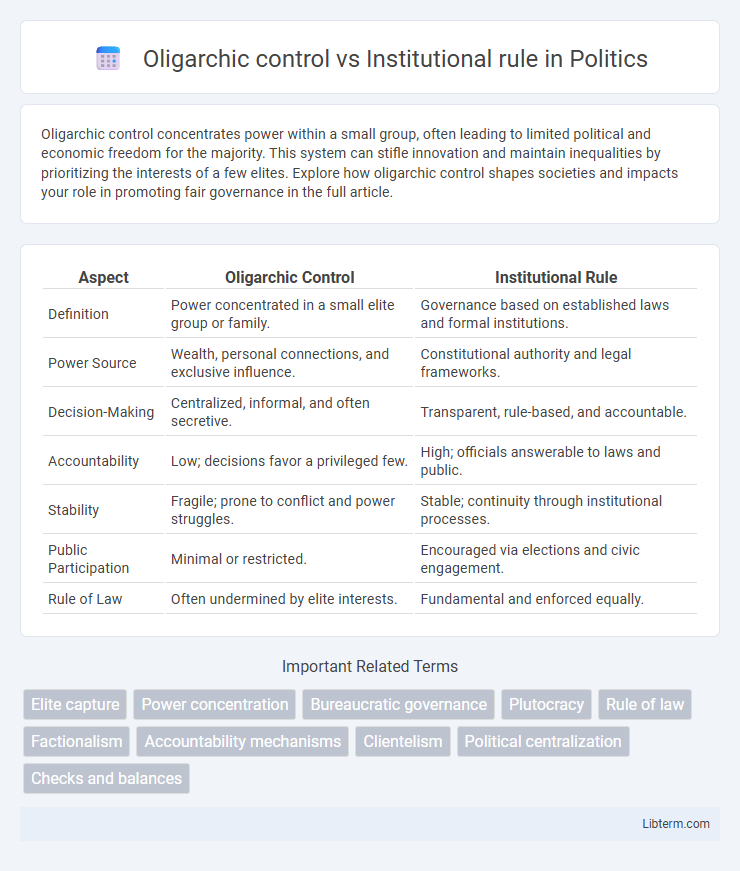Oligarchic control concentrates power within a small group, often leading to limited political and economic freedom for the majority. This system can stifle innovation and maintain inequalities by prioritizing the interests of a few elites. Explore how oligarchic control shapes societies and impacts your role in promoting fair governance in the full article.
Table of Comparison
| Aspect | Oligarchic Control | Institutional Rule |
|---|---|---|
| Definition | Power concentrated in a small elite group or family. | Governance based on established laws and formal institutions. |
| Power Source | Wealth, personal connections, and exclusive influence. | Constitutional authority and legal frameworks. |
| Decision-Making | Centralized, informal, and often secretive. | Transparent, rule-based, and accountable. |
| Accountability | Low; decisions favor a privileged few. | High; officials answerable to laws and public. |
| Stability | Fragile; prone to conflict and power struggles. | Stable; continuity through institutional processes. |
| Public Participation | Minimal or restricted. | Encouraged via elections and civic engagement. |
| Rule of Law | Often undermined by elite interests. | Fundamental and enforced equally. |
Defining Oligarchic Control
Oligarchic control refers to the dominance of a small, elite group over political and economic power, often prioritizing their interests above the broader population. This concentration of authority limits democratic participation and centralizes decision-making within the hands of a few influential individuals or families. Such control contrasts with institutional rule, where governance is structured around established laws, procedures, and organizations designed to ensure accountability and representation.
What Constitutes Institutional Rule
Institutional rule is defined by established structures and processes that ensure transparency, accountability, and the rule of law, contrasting sharply with oligarchic control where power is concentrated in the hands of a few. It relies on formal laws, independent judiciary systems, and checks and balances that distribute authority across various branches of government. Effective institutional rule promotes inclusive governance, protects individual rights, and sustains social order through predictable and impartial enforcement of rules.
Historical Examples of Oligarchies
Historical examples of oligarchies include the Venetian Republic, where power was concentrated in a small group of merchant families who controlled trade and governance. Ancient Sparta also exemplified oligarchic control, with a dual monarchy supported by a council of elders dominating political decisions. These cases highlight how oligarchic systems prioritize concentrated authority among elite groups, contrasting with institutional rule that emphasizes broader legal frameworks and distributed power.
The Evolution of Institutional Governance
The evolution of institutional governance reflects a shift from oligarchic control, where power is concentrated among a few elites, to more structured systems emphasizing accountability and transparency. Institutional governance promotes the development of formal rules, standardized procedures, and independent oversight mechanisms that mitigate the risks of power centralization inherent in oligarchies. This transformation enhances organizational resilience and aligns governance practices with democratic principles and stakeholder interests.
Power Concentration: Oligarchic vs. Institutional
Oligarchic control centralizes power in the hands of a few elite individuals or families, enabling swift decision-making but often leading to unequal resource distribution and limited accountability. Institutional rule disperses authority across formal organizations and established procedures, promoting transparency, checks and balances, and stable governance. Power concentration in oligarchies tends to override institutional frameworks, whereas institutional rule constrains individual dominance through codified laws and collective oversight.
Accountability and Transparency Differences
Oligarchic control often leads to limited accountability as power is concentrated in the hands of a few individuals or families, resulting in opaque decision-making processes and restricted public oversight. In contrast, institutional rule typically embeds mechanisms for accountability through formal checks and balances, transparent procedures, and public access to information. These differences significantly impact governance quality, with institutional rule promoting greater transparency and enabling citizens to hold leaders accountable.
Social and Economic Impacts
Oligarchic control concentrates wealth and political power among a small elite, leading to increased social inequality and limited economic mobility for the broader population. Institutional rule promotes transparency, accountability, and rule of law, fostering inclusive economic growth and reducing social disparities. Studies show that countries with strong institutional frameworks experience higher GDP growth rates and improved social welfare compared to those dominated by oligarchic structures.
Risks and Benefits of Each System
Oligarchic control centralizes power among a small elite, which can lead to efficient decision-making and stability but risks corruption, lack of accountability, and suppression of dissent. Institutional rule distributes authority through established laws and frameworks, promoting transparency, fairness, and protection of rights, though it may result in slower decision processes and bureaucratic inertia. Both systems carry trade-offs between concentration of power and procedural legitimacy, impacting governance quality and social equity.
Case Studies: Oligarchic and Institutional Leadership
Case studies of oligarchic and institutional leadership reveal distinct power dynamics and governance outcomes. In oligarchic control, concentrated wealth and influence shape policy decisions, as observed in Russia's post-Soviet political elite or Chile's Pinochet-era power structures. Institutional rule emphasizes legal frameworks and bureaucratic accountability, exemplified by the U.S. federal system or Germany's parliamentary democracy, promoting stability and rule of law.
Future Prospects: Balancing Control and Rule
Future prospects in balancing oligarchic control and institutional rule hinge on integrating transparent governance mechanisms that limit concentrated power while enforcing robust regulatory frameworks. Emerging technologies such as blockchain offer potential for enhanced accountability and decentralized decision-making, fostering a more equitable distribution of influence. Strategic reforms emphasizing stakeholder engagement and institutional resilience can mitigate risks of authoritarian dominance and promote sustainable democratic practices.
Oligarchic control Infographic

 libterm.com
libterm.com